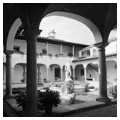This bluff-top mansion, originally called “Sopra Mare” (Italian for “above the sea”), was designed by Chicago architect Adler in the then-popular Mediterranean Revival style. As typical for the style, the house is oriented around a central courtyard, surrounded by an open-arcaded gallery, a pattern often incorporated into the design of Italian and Spanish villas during the Renaissance. Although a charming and functional feature for houses in mild climates, open-courtyard houses are rare and impractical in colder regions like Wisconsin. Nevertheless, in the center of the courtyard, an eight-foot-tall stone statue of the Greek god Hermes braves the winter cold. Cyril Colnik forged the fine wrought-iron gate, sconces, and door hardware. The villa’s interior contains further Mediterranean-style decorative features, such as the living room’s beamed and hand-stenciled cypress ceiling, stone fireplaces, handmade door hardware, handsome period furnishings, and original lighting fixtures. The house became a decorative-arts museum when the owners donated the building to Milwaukee County in 1966.
You are here
Villa Terrace Decorative Arts Museum (Lloyd Smith House, “Sopra Mare”)
If SAH Archipedia has been useful to you, please consider supporting it.
SAH Archipedia tells the story of the United States through its buildings, landscapes, and cities. This freely available resource empowers the public with authoritative knowledge that deepens their understanding and appreciation of the built environment. But the Society of Architectural Historians, which created SAH Archipedia with University of Virginia Press, needs your support to maintain the high-caliber research, writing, photography, cartography, editing, design, and programming that make SAH Archipedia a trusted online resource available to all who value the history of place, heritage tourism, and learning.












